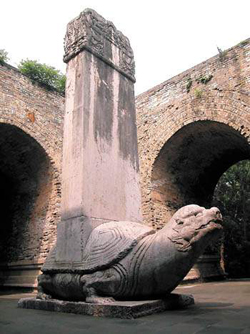Ming Xiaoling Mausoleum
Ming Xiaoling Mausoleum is one of the biggest imperial tombs in China. It lies in the eastern suburbs of Nanjing City at the southern foot of Zhongshan (Purple) Mountain. Emperor Chengzu, Zhu Yuanzhang, the first emperor of the Ming Dynasty (1368-1644) and Queen Ma were buried there.

Construction of the mausoleum began in 1381 and was completed in 1431. In 1384, Queen Ma died and was buried there. Emperor Chengzu had bestowed upon her the title 'Queen of Xiao Ci' which means 'Queen of Filial Piety and Kindness.' Hence, the name Ming Xiaoling derives from her title.
The mausoleum has two discreet sections: One is the Sacred Way area and the other is the main body of the mausoleum itself.

At the entrance to the mausoleum, you will see the Dismounting Archway. As a gesture of deep respect, visitors would discount their horses and sedans at this point. Not far from the entrance is the Tablet Pavilion called Si Fang Cheng. Here a majestic tablet was erected by order of Emperor Zhu Di, the fourth son of Zhu Yuanzhang, to eulogize his father's merits and virtues. The tablet is carried by Bixi, a legendary animal in the shape of a tortoise. Walking northwesterly across the bridge, you will see the winding 1800-meter long Sacred Way. Its middle section runs east-west and is called Shi Xiang Road. It is lined with several pairs of stone sculptured animals guarding the tomb. Each animal is postured differently and each conveys an auspicious meaning. For example, the lions, king of the animals, show the stateliness of the emperors, the camels, symbol of desert and tropical areas, indicate the vast territory of the dynasty and the elephants imply that the policies of the dynasty are to meet the desire of the grass root and the stabilization of the dynasty. Beyond the animals is a pair of decorative columns called Hua Biao that are carved with dragons. From here the Sacred Way turns into a north-south direction and becomes known at Weng Zhong Road. This location is marked by stone carved statues of ministers and generals. Different from the straight sacred ways in the former dynasties, the Sacred Way at Ming Xiaoling goes in different directions making it unique and unprecedented in Chinese history.
|

